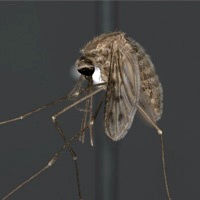Exploring Malaria-Carrying Mosquitoes
Malaria was eliminated from the United States by 1951. Elimination means it is gone, right? Forever? Well, not exactly.
 According to the Centers for Disease Control and Prevention (CDC), about 1,500 cases of malaria are diagnosed each year in the U.S., predominantly in travelers or immigrants coming from countries where malaria transmission is common, primarily from sub-Saharan Africa and South Asia. Could malaria make a come-back in this country? It is not out of the realm of possibility. The malaria parasite (Plasmodium) that causes the disease symptoms in humans was almost eliminated in North America through targeted mosquito control efforts in the early 1900s that included large-scale mosquito spraying (including the use of DDT), and swamp drainage. However, Anopheles quadrimaculatus – one of the primary carriers of the disease parasite in pre-1950s U.S. – is far from eradicated.
According to the Centers for Disease Control and Prevention (CDC), about 1,500 cases of malaria are diagnosed each year in the U.S., predominantly in travelers or immigrants coming from countries where malaria transmission is common, primarily from sub-Saharan Africa and South Asia. Could malaria make a come-back in this country? It is not out of the realm of possibility. The malaria parasite (Plasmodium) that causes the disease symptoms in humans was almost eliminated in North America through targeted mosquito control efforts in the early 1900s that included large-scale mosquito spraying (including the use of DDT), and swamp drainage. However, Anopheles quadrimaculatus – one of the primary carriers of the disease parasite in pre-1950s U.S. – is far from eradicated.
Also known as the Common Malaria Mosquito, Anopheles quadrimaculatus is distributed throughout the eastern United States, often occurring in huge numbers in the southeastern states, especially along the Gulf of Mexico. This fact reinforces the importance of strong surveillance and disease testing programs in areas where the species inhabits. It is not unusual for VDCI’s surveillance traps set in the Mississippi Delta region to collect over 7,000 mosquitoes in one night, of which 99% are likely to be this species.
Female Anopheles mosquitoes lay their eggs individually on the surface of freshwater pools, preferring ponds and lakes with large amounts of vegetation, including rice fields. The eggs have floats on each side, keeping them on the water’s surface. Larvae hatch out usually within two or three days. Unlike the mosquito species previously featured in this series, Anopheles larvae lack a breathing siphon at the end of their abdomen. They rest parallel to the water’s surface and take in oxygen through palmate hairs along the abdomen. Like other mosquitoes, the pupae are active but do not feed. The entire life cycle – from egg to larva to pupa to adult – can take as little as five days when temperatures are warm mid-season, but usually requires one to two weeks for development. Adults usually live for a couple of weeks.
For a mosquito with such a deadly history for humans in North America, it is a rather frail species, with long spindly legs and a thin body. The species name, quadrimaculatus, means “four-spotted” in Latin, referring to the pattern of scales on their wings that cluster into four distinct patches, easily visible without magnification. Genetic studies have determined that this is actually a species complex – a group of at least five species that are genetically distinct, but similar enough in appearance that we cannot tell them apart morphologically with a standard dissecting microscope. Apparently, they can tell each other apart, but we do not know exactly how.
So, with such high numbers of Common Malaria Mosquitoes in some parts of the U.S., why isn’t malaria a more common vector-borne disease here? There are probably many reasons. First, a person with the Plasmodium parasite must be bitten by an Anopheles mosquito. Then, the mosquito needs to live long enough for the parasite to develop into an infective stage. Finally, the mosquito needs to bite another human to pass the parasite along. In many parts of the country where these mosquitoes are common, most houses have screened windows and many are air-conditioned. Many communities also have large-scale mosquito surveillance and control programs in place to reduce the populations to levels where disease transmission is less likely. Small localized transmission could occur, but large-scale epidemics are much less likely today.
Contact Us to Learn More About Effective Mosquito Management Strategies:
 Since 1992, Vector Disease Control International (VDCI) has taken pride in providing municipalities, mosquito abatement districts, industrial sites, planned communities, homeowners associations, and golf courses with the tools they need to run effective mosquito control programs. We are determined to protect the public health of the communities in which we operate. Our mosquito control professionals have over 100 years of combined experience in the field of public health, specifically vector disease control. We strive to provide the most effective and scientifically sound mosquito surveillance and control programs possible based on an Integrated Mosquito Management approach recommended by the American Mosquito Control Association (AMCA) and Centers for Disease Control and Prevention (CDC). VDCI is the only company in the country that can manage all aspects of an integrated mosquito management program, from surveillance to disease testing to aerial application in emergency situations.
Since 1992, Vector Disease Control International (VDCI) has taken pride in providing municipalities, mosquito abatement districts, industrial sites, planned communities, homeowners associations, and golf courses with the tools they need to run effective mosquito control programs. We are determined to protect the public health of the communities in which we operate. Our mosquito control professionals have over 100 years of combined experience in the field of public health, specifically vector disease control. We strive to provide the most effective and scientifically sound mosquito surveillance and control programs possible based on an Integrated Mosquito Management approach recommended by the American Mosquito Control Association (AMCA) and Centers for Disease Control and Prevention (CDC). VDCI is the only company in the country that can manage all aspects of an integrated mosquito management program, from surveillance to disease testing to aerial application in emergency situations.

